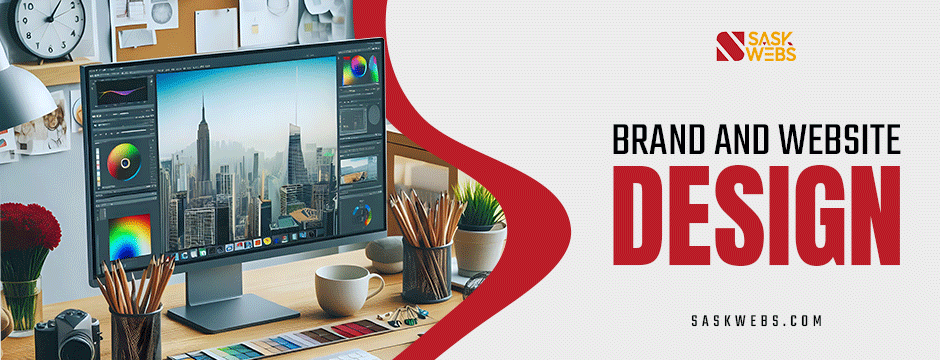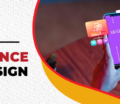
In this constantly changing field of digital design, staying ahead of the curve is crucial for brands aiming to make a lasting impression. As we move into 2024, several emerging trends in brand and website design are set to reshape the digital landscape. Understanding these trends can help businesses refine their online presence and stay competitive. Here’s a comprehensive look at the top trends in website and brand design for 2024 and what you need to know to leverage them effectively.
1. Minimalist Design with a Twist
Minimalism remains a strong trend in design, but in 2024, it’s evolving with new features. Brands now add unique and eye-catching elements to their designs while still keeping things simple and clean. This means you’ll see bold typography, surprising colour accents, and detailed touches that make a design stand out without being too busy. The goal of this trend is to keep things clear and focused while still allowing for creativity and personality.
2. AI-Powered Personalization
Artificial Intelligence (AI) is getting more advanced and it’s changing how websites interact with users. AI-powered personalization helps websites provide content and suggestions that match users’ behaviour and preferences. This means that users will see product recommendations and content that are tailored to their interests. For brands, using AI to personalize experiences can lead to more user engagement and higher conversion rates.
3. Interactive and Immersive Experiences
Interactive elements are now essential in modern web design. They are more than just added features and also important for making websites engaging. Dynamic scrolling effects, interactive infographics, and immersive storytelling are examples of how these elements make websites more captivating. These features help create memorable experiences and allow users to connect more deeply with a brand. In 2024, we can expect even more innovative uses of interactive design, including 3D animations and virtual reality (VR) integrations. These advancements will make websites more exciting and engaging for users.
4. Sustainable and Ethical Design
Sustainability is becoming increasingly important in design, and this includes website design. Brands are adopting eco-friendly practices such as using energy-efficient coding and selecting green hosting solutions to reduce their environmental impact. Additionally, design elements are chosen to promote environmental awareness. Ethical design is also crucial, ensuring websites are accessible to people of all abilities and backgrounds. This focus on sustainability and inclusivity reflects a broader commitment to social responsibility and resonates with consumers who are more conscious of environmental and social issues.
5. Bold and Experimental Typography

In 2024, typography is taking the spotlight with designers embracing bold and unique fonts to craft memorable brand identities. Custom typefaces and creative text styles are becoming more common, often blending seamlessly with other design elements. This trend in bold typography not only enhances the visual appeal of a brand but also strengthens its messaging and personality. By using striking and unconventional fonts, brand and website design can create a distinctive look that stands out and effectively communicates their identity.
6. Neumorphism and Soft UI
Neumorphism also known as “soft UI,” is becoming popular in design. It is known for its soft-shadow effects and smooth, tactile appearance. This style uses shadows and light to make interface elements look like they are either slightly raised above or pressed into the background. Neumorphism gives a sense of depth and realism. It provides a new look compared to traditional flat design and adds elegance and sophistication to modern websites.
7. Data Visualization and Infographics
As data becomes more crucial in decision-making, the need for clear data visualization is increasing. Brands are using advanced infographics and data visualization methods to present complicated information in an easy-to-understand and engaging way. Websites are now featuring interactive charts, graphs, and maps as standard tools. These elements help users easily grasp and interact with data, making complex information more accessible and understandable.
8. Micro-Interactions and Animations
Micro-interactions are small, subtle animations that occur in response to user actions on a website, enhancing the overall experience. These animations, such as a button changing colour or moving when clicked, provide immediate feedback and help users understand that their actions are being processed. They also guide users through tasks, making websites more intuitive and engaging. In 2024, expect to see even more creative and meaningful micro-interactions that not only add visual interest but also improve usability to make websites more enjoyable and easier to navigate.
9. Voice User Interface (VUI)
With the growing adoption of voice-activated devices, integrating Voice User Interfaces (VUI) into website design is becoming increasingly important. VUI enables users to interact with websites using voice commands, offering a hands-free and efficient way to navigate and perform tasks. Brands are exploring ways to incorporate features like voice search, voice commands, and conversational interfaces to enhance accessibility and improve the overall user experience. By integrating VUI, websites can become more user-friendly and accessible, allowing visitors to engage with content more naturally and conveniently.
10. Enhanced Mobile Design
Mobile design is crucial as phone usage grows. In 2024, the focus is on creating smooth mobile experiences with responsive design that adjusts to various screen sizes. Fast loading times are essential to prevent user frustration, and touch-friendly interfaces ensure easy navigation on touchscreens. Mobile-first design is now standard, meaning websites are often designed for mobile devices first before adapting to larger screens. This approach ensures websites are effective and user-friendly on all devices.
Conclusion
As we move through 2024, these trends in brand and website design will shape how businesses connect with their audiences and differentiate themselves in the digital space. Embracing minimalist yet bold designs, leveraging AI for personalization, and incorporating interactive and immersive elements can set your brand apart. Additionally, focusing on sustainability, experimenting with typography, and enhancing mobile and voice interfaces will help you stay relevant and engaging in an ever-evolving digital landscape. By staying informed and adapting to these trends, you can create compelling website and brand designs that resonate with your audience and drive success.
Elevate your brand and website for 2024 and beyond by transforming your digital presence with Saskwebs, where cutting-edge technology and creative design come together.






